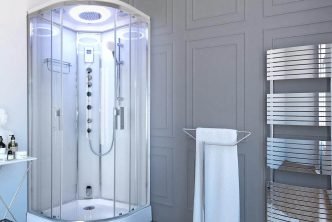Track lighting is a highly adaptable and customizable lighting solution that can be used in almost any setting or area. It is ideal for providing ambient or general lighting, task lighting, or even accent lighting for art, shelves, or other interesting objects. These lights add both aesthetic appeal and practicality to a space.
Table of Contents
Why Should You Choose Track Lighting?
Track lighting is becoming increasingly popular as a way to upgrade your home and add a touch of style. One of the reasons for its popularity is that it’s easy to install and highly adaptable in terms of design. This means you can direct the light to focus on any item you choose, and a wide range of options are available in terms of style and type. Additionally, recessed lighting takes up very little space and can be installed in tight areas.
What Do You Need to Know Before Buying?
Types of Tracks
- Standard (Linear)
Standard (Linear) track lighting includes several light fixtures attached to a single straight rail, which can hold many lights and be moved anywhere along the bar.
- Flexible
Flexible tracks are able to be curved to create rounded shapes that complement the style of the room.
- Cable
When you think of track lighting, the cable design style is likely the first to come to mind. This type of lighting features thin wires or cables wrapped around a rail that is hung from the ceiling. The lights are then screwed directly into the cable.
- Pendant
Pendant lights are hung from the track on a down rod and can be set to different heights to create an interesting effect and varied lighting.
- Magnetic
Magnetic track lighting has magnets built into the track, making it easy to snap the light onto the track without requiring a hooking mechanism during installation. However, it is important to ensure that the light is compatible with the magnetic holder before installation. This type of track lighting is straightforward and convenient to use.

Types of Track Heads
Track heads are an essential component of luminaries’ lighting systems. These systems provide a versatile lighting option for any room in your home. They are available in different shapes and designs, making them perfect for any aesthetic preference.
There are several different types of track heads. Cylinder heads are perfect for a sleek and modern look. Round-back heads provide a more traditional feel. Pinhole heads are great for highlighting specific areas of a room. Cube heads provide a unique and contemporary design. Octagonal heads offer a classic and elegant look. Stepped and multi-stepped heads are perfect for adding depth and dimension to a room. Wire back heads are great for an industrial feel. Gimbal heads offer the ability to adjust the direction of the light. Clasp-fingered heads are perfect for a clean and minimalist look. Barn door heads offer a rustic and charming feel. Finally, pendant heads offer a unique and stylish option for a variety of lighting systems.
In short, the wide variety of track heads available makes it easy to find the perfect lighting option for any room in your home.
Connector Types and Compatibility
When it comes to track head connections, there are three main types that you should be aware of: J, H, and L. Each of these types has its own unique characteristics and is compatible with certain components. It is important to choose the head connection type that matches the components of the same type, as mixing and matching different types can result in compatibility issues.
For example, the J-type track head connection is designed with two metal prongs that fit into a track with corresponding slots. This type of connection is best suited for low-voltage lighting systems and is typically used in residential applications. On the other hand, the H-type track head connection is designed with a single metal prong that fits into a track with a corresponding groove. This type of connection is best suited for high-voltage lighting systems and is commonly used in commercial applications.

Lighting Technology
The type of lightbulb you can use with your modern track lighting depends on the type of head you choose. LED, halogen, incandescent, and fluorescent bulbs are all options, but make sure your track lighting is compatible with the style and voltage of the bulb you prefer.
Single-Circuit vs. Double-Circuit
Single-circuit track lighting controls all track heads with one circuit, so they are all controlled at the same time by the same switch. Double-circuit track lighting has two circuits, so some lights are controlled separately. This allows you to set two lighting settings on the same track light unit, such as ambient and accent lighting, for a nearby picture or task lighting while reading.
Line Voltage vs. Low Voltage
It’s important to be aware of voltage requirements when selecting track lighting. Line voltage track lights are wired directly into the house like other lighting fixtures and typically work with the standard 110 or 120-volt system. On the other hand, low-voltage track lights require transformers or adapters to connect to your home’s wiring system and use only 12 to 24 volts.
Other Features
Track lighting systems often come with extra features or may be compatible with add-on accessories. For instance, dimmer switches allow you to adjust the brightness of the light to a specific level. Lenses can be added to the track heads to lengthen or broaden the light beam, or colored lenses can be included to change the color of the lighting. If any of these features are important to you, make sure to consider what your track lighting system includes or what types of features it can accommodate.
Conclusion
In conclusion, track lighting is a versatile and stylish lighting solution that can enhance the ambiance of any space. You can create a lighting system that meets your specific needs and preferences with a wide variety of options, including different types of tracks, track heads, and lighting technologies. Consider the factors discussed above when choosing track lighting for your home, and enjoy the benefits of this adaptable and customizable lighting solution.





